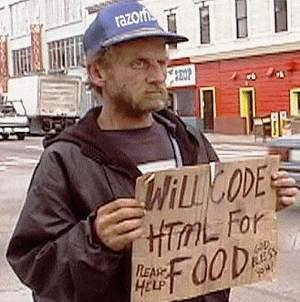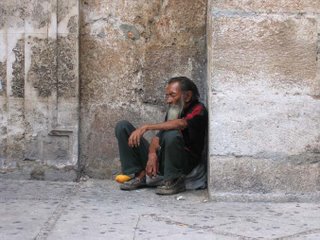
From WIRED.com I found the following article.
I remember when Michael Stoops who is mentioned in this article was working for the homeless issues in Portland Oregon. Due to some mistakes he made, he left town and now is involved at the national level with the
National Coalition for the Homeless
...same battle bigger playing field.
Here is the article:
"Laptops Give Hope to the Homeless"
By Jacob Ogles Jun, 22, 2006
FILLMORE, California -- Happy Ivy doesn't have a bathroom or a kitchen in the bus he calls home. He does, however, have a video-editing station.
Living in a squalid, Woodstock-style bus parked in a Fillmore, California, orange grove, the 53-year-old homeless man charges a power generator from a utility shed and uses Wi-Fi from a nearby access point. From this humble camp, he's managed to run a 'round-the-clock internet television studio, organize grassroots political efforts, record a full-length album and write his autobiography, all while subsisting on oranges and avocados.
He claims he created one of the first handheld computer scanners and played a major part in the data transmission industry in the early 1990s. "I've always been trying to stay up on internet technology," Ivy said.
Ivy isn't the only homeless person who makes it a priority to keep gadgets handy even when a cooked meal is hard to come by.
Many of those now living without a permanent roof over their heads have cell phones in their pockets or laptop computers at their hips. While people living in shelters and alleys have found it difficult to cross social divides, the digital divide seems to disappear on the streets. Nearly all homeless people have e-mail addresses, according to Michael Stoops, director of the National Coalition for the Homeless. "More have e-mail than have post office boxes," Stoops said. "The internet has been a big boon to the homeless."
Helping the homeless get e-mail addresses has been a priority for years at shelters across the country. And in an age when most every public library in the nation offers internet access, the net has proven a perfect communication tool for those without a firm real-world address.
"Because of technology, people are able to keep in contact with their families," Stoops said. And perhaps most importantly, they are able to get some footing in society regardless of how removed from it they may feel.
Terri Hellerich's connection to the information superhighway is all that made life livable on the streets. "It kept me sane and provided my income," she said. Hellerich found herself homeless after a landlord in West Sacramento kicked her out and kept her belongings to make up for a debt. She didn't have a change of clothes, but she did have an old cell phone that she could use to stay online and check her inbox.
Hellerich slept on benches but she frequented a women's shelter with a cluster of internet-connected computers used mostly by the children who arrived at the safe house with their mothers. She started blogging and conducting a business. As an independent internet marketer, she was able to maintain bank accounts, nurse existing client connections and forge new business relationships. The business brought in only about $100 a month, but that was enough to help get her life back on track.
Hellerich now rents a room in Northern California, and she's bought an old computer and broadened her online presence with MySpace and Flickr pages. But she lives in fear that at any point, circumstances could throw her back into the urban wilderness.
And while many homeless people are quick to talk about the empowering elements of the internet, experts emphasize that technology won't erase the aspects of one's personal life that put them on the streets in the first place. "People believe that information is power, and it is sometimes, but it is still a complicated system," Stoops said. It is rare for technology alone to pull someone out of the cycle of habitual homelessness.
But if the internet can't provide the homeless with an out, it can at least provide them with an outlet. Stoops knows numerous cases where modern technology has afforded valuable opportunities to the homeless.
Las Vegas vagrant Kevin Barbieux runs a blog that's brought him a dose of digital stardom. He's been writing The Homeless Guy since 2002. "It's the only real success I've had in my life," he said.
His site isn't the only one on the web with entries about life on the street. WanderingScribe features the ramblings of a homeless woman in England. In Peoria, Willie York has a site devoted to giving advice on street life. And other online efforts have had mainstream attention in the past few years, from New York to California.
Barbieux's site garners 12,000 to 15,000 hits a month. He attributes that to the storytelling ethic of his posts, which detail not only his own travails, but those of colleagues in shelters and city parks. He also comments on the public's perceptions of the homeless, and the factors that force so many of his compatriots into a holding pattern of poverty. "The work I do on my blog is geared toward telling, not just my story, but the story of every homeless person," he said. "If it's just about me then its effect will be limited. I really want to change the world."
If it changes his own life a bit more that would be nice, too. But for now, Barbieux, sans residence, does his blogging in one-hour stints at a public library terminal. He had a Wi-Fi-equipped laptop donated to him through his site, but the machine was damaged and Barbieux has no resources to replace it.
Las Vegas is a great city for Wi-Fi, Barbieux said: You can connect from outside most any hotel or casino, and the homeless keep each other informed about the best hot spots. Technology has helped him collect donations through a PayPal button on his web page instead of having to panhandle.
When he first got online in 1997, he saw a world where one could interact with people without awkward looks and hold conversations without difficult social interactions.
"I have social anxiety issues, and being able to communicate with folks without having an attack was great, and I discovered that I actually had a personality that people liked when I chatted with them," he said. When friends at an internet discussion group suggested he start a blog in 2002, Yahoo tagged it one of the top 10 "new and notable" sites on the web. Suddenly he felt he had the world's attention. "I could be doing other things with my time," he said, "but I can't think of anything else that could be so vital."
Like Barbieux, Ivy hopes to change the world through the power of the web. Living with his wife in his $400 About Us Bus for the past three years, Ivy has driven much of California trying to raise awareness of the homeless, or as he prefers to call them, the home-free.
A head injury made it impossible for Ivy to hold a steady job, he said. But he has embarked on several tech efforts. He claims he helped establish the company which would become Omnifax, though he never saw a dime from the effort and lost touch with his business partners. Omnifax is now a division of Xerox, which did not return a call for a comment.
From his bus, he broadcast the 24-hour internet television show About Us Now in the early days of streaming video. Showcasing music concerts on the beach and offering a glimpse of his Bedouin lifestyle, Ivy believes his was the first successful internet television network. Though he doesn't maintain the show anymore, he still works on internet video -- for most of this year, he's following the United Souls of Awareness, a group of homeless artists embarking on a walk across the country.
Ivy insists he's homeless by choice: He was never comfortable living in apartments. "Walking out the door and seeing everybody had the same door, it would make me get violent, to tell you the truth," he said. But he hopes his efforts online will raise awareness of the plight of the involuntarily homeless community, whose numbers skyrocketed with the Reagan administration policies of the 1980s.
Having a presence online can be a problem. Hellerich deleted most blog posts from her homeless days when a prospective employer Googled her and found the page (it cost her the job). People have contacted Ivy, asking why he can't hold a job but can play the guitar every day. He responds that many days he can't play the guitar, but his vagabond lifestyle is his choice.
While homeless people lurk in the shadows of the physical world, Stoops sees many of them stepping into the virtual sunshine.
"I think people often try to hide the fact they are homeless because they are ashamed of it," Stoops said. "But more and more, others are sort of coming out of the closet. You see writers and poets. There is really a niche of homeless writers now, and I am amazed at that. This is the hook to get people to listen."
Read the original post for this article below:
http://www.wired.com/news/technology



